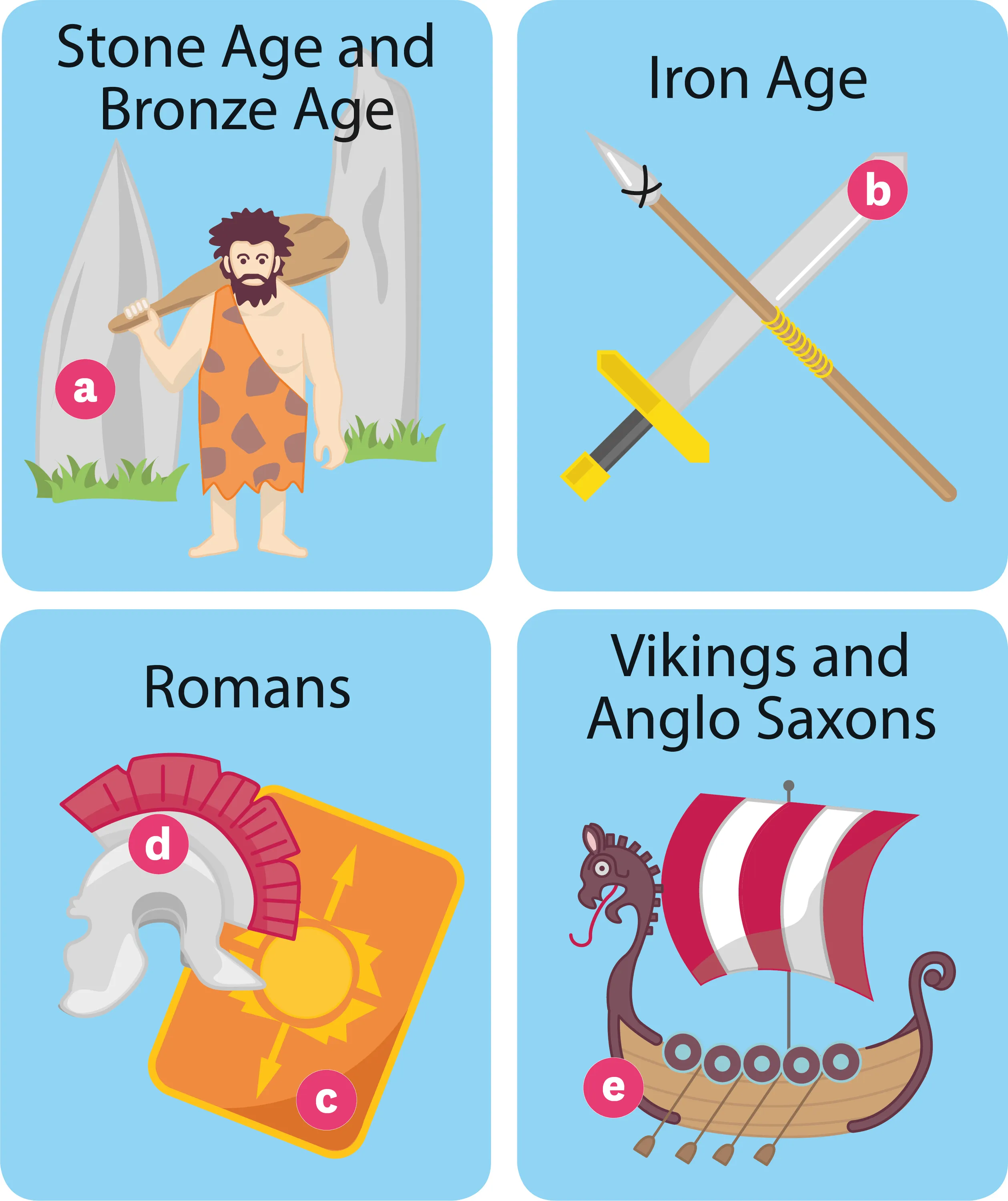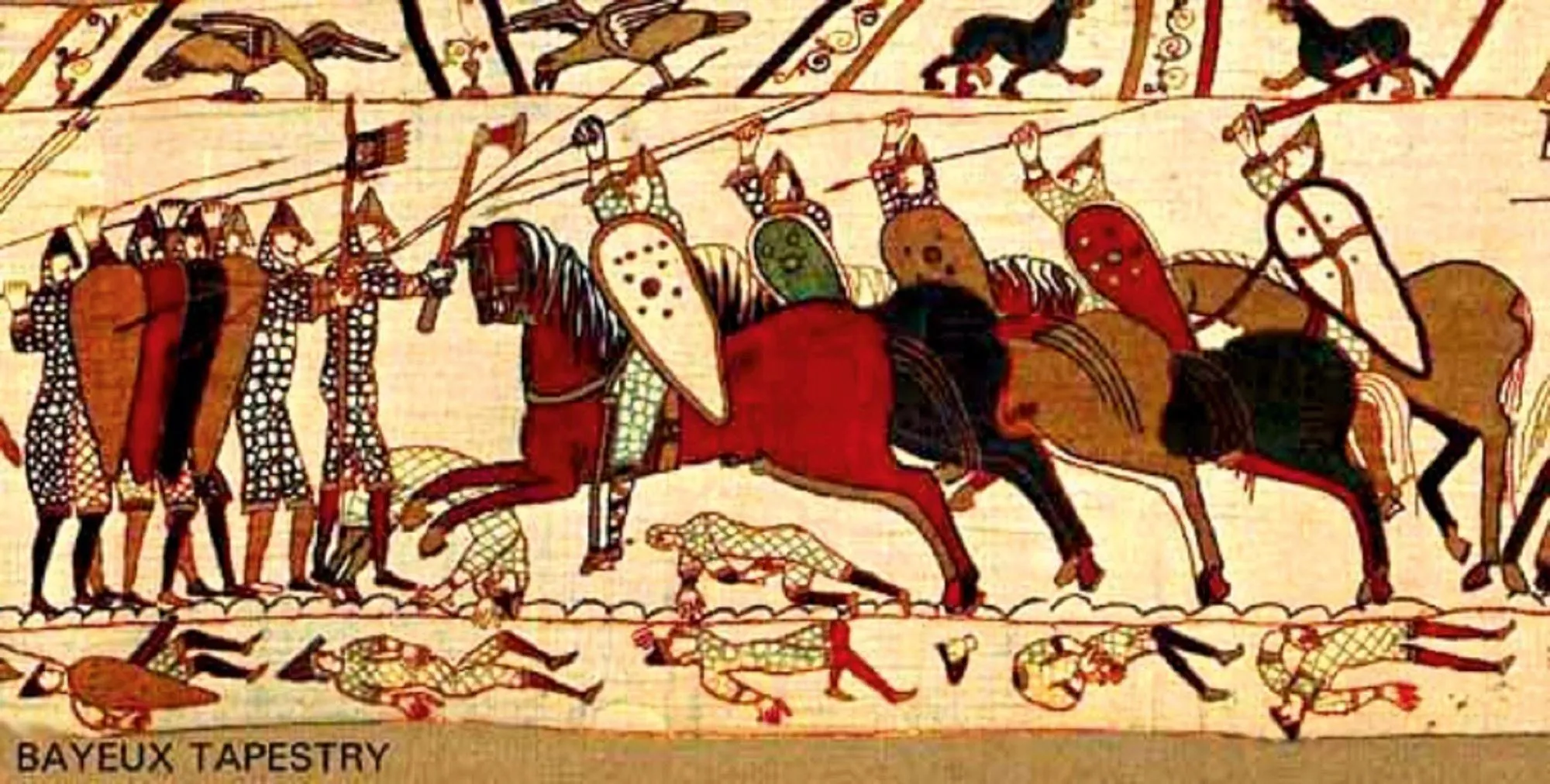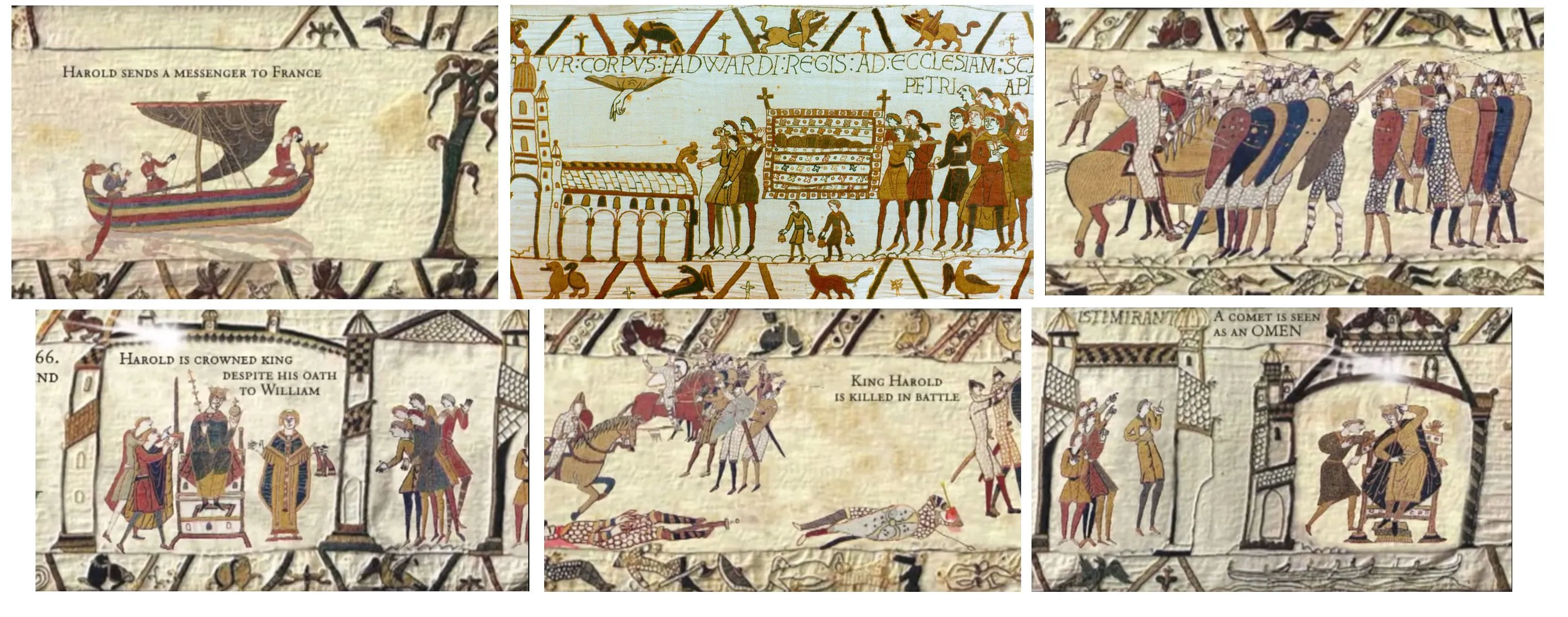Ressource affichée de l'autre côté.
Faites défiler pour voir la suite.
Faites défiler pour voir la suite.
1. William the Conqueror is called Guillaume le Conquérant in France.
2. Prince Harry's real name is Harriet.
2. Prince Harry's real name is Harriet.
Ressource affichée de l'autre côté.
Faites défiler pour voir la suite.
Faites défiler pour voir la suite.
1Before the Normans…
Ressource affichée de l'autre côté.
Faites défiler pour voir la suite.
Faites défiler pour voir la suite.
Activities
1. Match the objects to the pictures, and one adjective to each object.


2. Fill in the text with the dates below to complete the story before the Normans.
3. The Norman Kings ruled Britain from 1066 until 1154 AD. Place these events in the table. Find information online if necessary.


| a. | ||
| b. | ||
| c. | ||
| d. | ||
| e. |
2. Fill in the text with the dates below to complete the story before the Normans.
Tip
The story is chronological. BC: Before Christ. AD: Anno Domini.
The Stone Age ended around in Britain. The Iron Age approximately started in . The Romans conquered Britain in , and ruled until . Around , the Angles and the Saxons arrived, from Denmark and Germany. The first Viking attack in Britain happened in .
3. The Norman Kings ruled Britain from 1066 until 1154 AD. Place these events in the table. Find information online if necessary.
| Before the Normans | After the Normans |
Ressource affichée de l'autre côté.
Faites défiler pour voir la suite.
Faites défiler pour voir la suite.
Ressource affichée de l'autre côté.
Faites défiler pour voir la suite.
Faites défiler pour voir la suite.
2Mr Cray's crash course
Ressource affichée de l'autre côté.
Faites défiler pour voir la suite.
Faites défiler pour voir la suite.
Activities
1. Look at the picture. Are these statements about the battle right or wrong?


2. Complete the table with the correct Wh- words. Listen to the audio, focus on the people talking and fill in the table.
3. Summarise what you've just learned from Mr Cray's history lesson.
This audio document is a (subject) lesson. Mr Cray and his students are talking about (name of the Battle) between the and the . The medieval Bayeux tapestry tells the story of the (geography) invasion lead by (the Norman leader) against (the Saxon leader).
4. On the picture of the tapestry, which army is on the left, and which army is on the right? How do you know the difference?


a) All of the soldiers had horses.
b) Some of the soldiers carried spears.
c) The soldiers had rectangular shields.
d) Both armies wore helmets.
e) Nobody died during the battle.
b) Some of the soldiers carried spears.
c) The soldiers had rectangular shields.
d) Both armies wore helmets.
e) Nobody died during the battle.
Mr Cray's crash course
| People talking | Place | Today's lesson |
| Wh... ↓ | Wh... ↓ | Wh... ↓ |
|
|
|
|
|
|
|
|
3. Summarise what you've just learned from Mr Cray's history lesson.
This audio document is a
4. On the picture of the tapestry, which army is on the left, and which army is on the right? How do you know the difference?
Tip
The Normans were riding horses and the Saxons were walking.
Ressource affichée de l'autre côté.
Faites défiler pour voir la suite.
Faites défiler pour voir la suite.
Ressource affichée de l'autre côté.
Faites défiler pour voir la suite.
Faites défiler pour voir la suite.
3Make it right!
Ressource affichée de l'autre côté.
Faites défiler pour voir la suite.
Faites défiler pour voir la suite.
Activities
1. Watch the video. Associate each picture to the correct part of the story.


The Normans killed King Harold. But how did he die? Some say that he was killed by an arrow to the eye, or hacked by a Norman knight. When Harold died, the battle was over.
On 5 January 1066, King Edward the Confessor died.
Harold Godwinson went to Normandy. Harold's ship landed in Ponthieu, north of Normandy, the land of the fierce Count Guy. Count Guy's soldiers captured Harold.
On 14 October 1066, the Battle of Hastings began. The air filled with arrows and lances. The English soldiers, who were all on foot, protected themselves with a wall of shields. The lower border of the tapestry is lled with dead and injured soldiers.
William decided to attack England.


6
5
2
3
4
1
On 6 January 1066, Harold became King of England.
The Normans killed King Harold. But how did he die? Some say that he was killed by an arrow to the eye, or hacked by a Norman knight. When Harold died, the battle was over.
On 5 January 1066, King Edward the Confessor died.
Harold Godwinson went to Normandy. Harold's ship landed in Ponthieu, north of Normandy, the land of the fierce Count Guy. Count Guy's soldiers captured Harold.
On 14 October 1066, the Battle of Hastings began. The air filled with arrows and lances. The English soldiers, who were all on foot, protected themselves with a wall of shields. The lower border of the tapestry is lled with dead and injured soldiers.
William decided to attack England.
Ressource affichée de l'autre côté.
Faites défiler pour voir la suite.
Faites défiler pour voir la suite.
Listen
Listen: 1. Did Harold die during the Battle of Hastings? 2. When did the Battle of Hastings take place?
Réfléchis : Dans la question 1 (question fermée), l'intonation est-elle montante ou descendante ?
Dans la question 2 (question ouverte), l'intonation est-elle montante ou descendante ?
Repeat
Répète : Why did William invade England? Was Harold happy to become King of England?
Ressource affichée de l'autre côté.
Faites défiler pour voir la suite.
Faites défiler pour voir la suite.
Les questions au prétérit simple
Observe :When did the Battle of Hastings happen? When was William's coronation?
Réfléchis : Dans chaque question, repère le verbe (s'il y en a un) et note l'auxiliaire.
Conclus : Si je veux poser poser une question concernant un fait présent ou passé, dois-je dois rajouter l'auxiliaire DO ou BE lorsque la question comporte déjà un verbe ? Sinon, dois-je utiliser le verbe DO ou BE ?
Ressource affichée de l'autre côté.
Faites défiler pour voir la suite.
Faites défiler pour voir la suite.
Mission 1
1. Your mission is to...
2. Most of the questions will use...
2. Most of the questions will use...
3. Choose your level:
Une erreur sur la page ? Une idée à proposer ?
Nos manuels sont collaboratifs, n'hésitez pas à nous en faire part.
j'ai une idée !
Oups, une coquille
